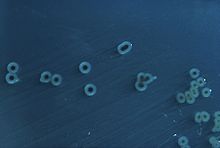Salmonella choleraesuis
| Salmonella enterica | |
|---|---|
 |
|
| S. enterica Typhimurium colonies on a Hektoen enteric agar plate | |
| Scientific classification | |
| Domain: | Bacteria |
| Kingdom: | Eubacteria |
| Phylum: | Proteobacteria |
| Class: | Gammaproteobacteria |
| Order: | Enterobacteriales |
| Family: | Enterobacteriaceae |
| Genus: | Salmonella |
| Species: | S. enterica |
| Binomial name | |
|
Salmonella enterica (ex Kauffmann & Edwards 1952) Le Minor & Popoff 1987 |
|
| Subspecies | |
|
S. enterica subsp. arizonae |
|
S. enterica subsp. arizonae
S. enterica subsp. diarizonae
S. enterica subsp. enterica
S. enterica subsp. houtenae
S. enterica subsp. indica
S. enterica subsp. enteritidis
S. enterica subsp. salamae
Salmonella enterica (formerly Salmonella choleraesuis) is a rod-shaped, flagellated, facultative anaerobic, Gram-negative bacterium and a member of the genus Salmonella. A number of its serovars are serious human pathogens.
Most cases of salmonellosis are caused by food infected with S. enterica, which often infects cattle and poultry, though other animals such as domestic cats and hamsters have also been shown to be sources of infection in humans. Investigations of vacuum cleaner bags have shown that households can act as a reservoir of the bacterium; this is more likely if the household has contact with an infection source (i.e., members working with cattle or in a veterinary clinic).
Raw chicken eggs and goose eggs can harbor S. enterica, initially in the egg whites, although most eggs are not infected. As the egg ages at room temperature, the yolk membrane begins to break down and S. enterica can spread into the yolk. Refrigeration and freezing do not kill all the bacteria, but substantially slow or halt their growth. Pasteurizing and food irradiation are used to kill Salmonella for commercially produced foodstuffs containing raw eggs such as ice cream. Foods prepared in the home from raw eggs such as mayonnaise, cakes, and cookies can spread salmonella if not properly cooked before consumption.
...
Wikipedia
